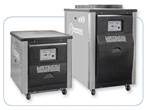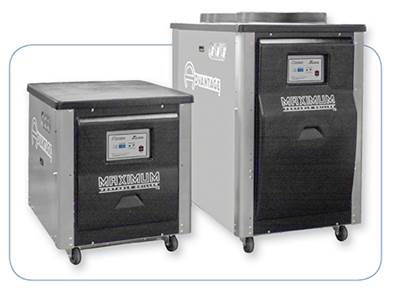Central or Portable? ‘Off-the-Floor’ Central Chillers Cost Less, Provide Processing Gains
In deciding whether to use portable or central chillers, there are a variety of variables to consider. Here are the key issues.
In deciding whether to use portable or central chillers, there are a variety of variables to consider. The first thing to do is to calculate the total cooling requirements of the plant. This should take into consideration material cooling, hydraulic cooling, and other items such as air compressors, machine barrels, feed throats, etc.
The desired temperature for optimal cooling then needs to be determined for each cooling point. Usually 85 F is sufficient for hydraulics and air compressors. Depending on the material being processed and the application, the desired temperature can run from 30 F to 500 F (requiring hot-water or oil temperature-control units).
Once all this information is compiled, it’s time to start evaluating what type of equipment will be best for the application and will work best in your plant. The most important criteria to consider are upfront cost, floorspace, noise, total operating cost, processing performance, and maintenance/reliability.
Every processor will say that he wants his chilling system to be invisible, provide continuous water at the correct temperature and pressure, and to never know it exists. This article examines the advantages offered by central chilling systems.
To start, it is important to identify what defines a central chilling system. It is the refrigeration unit itself, with either an integral or remote condenser, and the appropriate pumping system to circulate water through the chiller and the process.
•First-time cost: Portable chillers will cost more per ton of capacity than a central chiller. As an example, if a plant had nine machines each requiring 10 tons of chilling, the cost of 10 portables would be about $115,000, whereas a 90-ton central chilling system would be about $75,000. Installation costs can vary significantly depending on the specific plant layout, how much work is done internally versus contracted out, and how the portables are installed.
•Floorspace: In most plants, floorspace is at a premium. Portable chillers are located close to the process on the production floor, taking up valuable space that could be used for other equipment or more presses. Central chillers, on the other hand, can be located in an equipment room or outdoors.
•Noise level: Depending on whether air-cooled or water-cooled portable chillers are used (a topic for another article), the noise level can be quite high by the machine, affecting operators. Removing the cooling equipment from the production floor substantially reduces noise. Note that there are significant differences in noise levels among different types of central chillers. Noise levels for chillers using centrifugal compressors can be as low as 71 dbA, significantly quieter than chillers using other styles of compressors.
•Operating costs: Because a portable chiller must be sized for the largest mold that might be in the machine, it can be significantly oversized for other molds. Thus, with the most common style of portable chiller, using hot-gas bypass, it’s going to cost the same to run this portable for a mold requiring 10 tons of cooling as it will for a mold requiring 5 tons.
The benefit of a central system is that it combines the total load of all machines. Central chillers usually use either multiple scroll compressors that can be staged off and on to conserve energy, screw compressors that can be unloaded as needed, or centrifugal compressors with variable-speed drives that can adjust to the load.
It is not unusual to see a central chiller with screw or scroll compressors save 30% in energy use vs. individual portables. Oil-free, centrifugal-compressor chillers can save an additional 30% to 50% beyond those savings! If a central chiller is right for your application, be sure to investigate the alternative of using a remote-condenser, air-cooled chiller with a centrifugal compressor vs. a water-cooled central chiller and a cooling tower. Because these oil-free compressors can “float” the head pressure (by letting the refrigerant pressure adjust to the ambient air temperature), total installation and operating costs (including water, chemicals, and cooling-tower system energy) of the air-cooled system are often lower. (Note that compressors with oil must maintain higher refrigerant pressures for proper oil flow and lubrication.)
If the plant is air conditioned, an air-cooled portable chiller cannot be used at the press without adding a sizeable load to the air-conditioning equipment. In this case, if you want to use portables, the alternative is a water-cooled portable chiller, which requires a secondary cooling source (usually a cooling tower).
•Processing performance: Proper flow and pressure are critical factors for optimal processing. With portables, you have one pump designed for the largest mold. When running smaller molds, you waste energy by running the larger pump, and the flow probably has to be reduced. Since the majority of portables have one pump that pumps water through the process and the evaporator, this means flow to the evaporator is reduced as well. This affects the performance of the chiller and in some cases can cause an evaporator failure.
An option, of course, is to add a second, smaller recirculating pump for constant flow through the evaporator, but now you have increased your upfront cost and operating cost and have added another potential component to fail.
Central chilling systems have a dedicated pump for the chiller, so it receives optimal flow, and then a process pump to deliver water to the plant. This pump can be equipped with a variable-frequency drive to provide the ideal pressure and to reduce flow and save energy when full flow is not required.
•Maintenance considerations: Downtime is always a concern. With individual portables, if one fails, then that machine is down unless a spare portable chiller is available—and then it takes time to move it into place and connect it. With a central system, the pumping system is designed with built-in standby pumps for quick switchover in the event of a failure. One pump can be provided as a backup to either the process or recirculating pump. This pump is ready to go into production immediately in the event of a pump failure. The chiller itself can be oversized with an extra standby compressor. Many central chilling systems can use remote diagnostics to enable quick evaluation and resolution of an issue should a problem develop, reducing downtime and repair costs.
Every case is different, and central chillers are not right for all applications. Make sure to ask questions, explore the different technologies, and pay close mind to total operating cost.
Related Content
Using Data to Pinpoint Cosmetic Defect Causes in Injection Molded Parts
Taking a step back and identifying the root cause of a cosmetic flaw can help molders focus on what corrective actions need to be taken.
Read MoreHow to Reduce Sinks in Injection Molding
Modifications to the common core pin can be a simple solution, but don’t expect all resins to behave the same. Gas assist is also worth a try.
Read MoreOptimizing Pack & Hold Times for Hot-Runner & Valve-Gated Molds
Using scientific procedures will help you put an end to all that time-consuming trial and error. Part 1 of 2.
Read MoreA Systematic Approach to Process Development
The path to a no-baby-sitting injection molding process is paved with data and can be found by following certain steps.
Read MoreRead Next
Central or Portable? Flexibility Favors ‘Discrete’ Chillers
Why might discrete chillers be a solution in your plant? In a word: Flexibility. Here is the lowdown.
Read MorePeople 4.0 – How to Get Buy-In from Your Staff for Industry 4.0 Systems
Implementing a production monitoring system as the foundation of a ‘smart factory’ is about integrating people with new technology as much as it is about integrating machines and computers. Here are tips from a company that has gone through the process.
Read MoreMaking the Circular Economy a Reality
Driven by brand owner demands and new worldwide legislation, the entire supply chain is working toward the shift to circularity, with some evidence the circular economy has already begun.
Read More





















